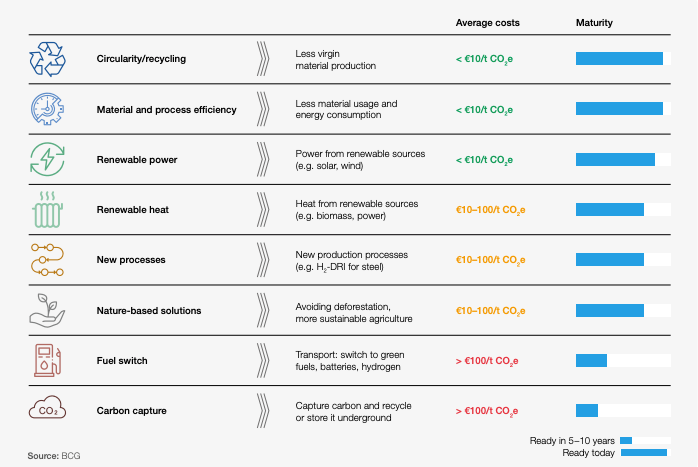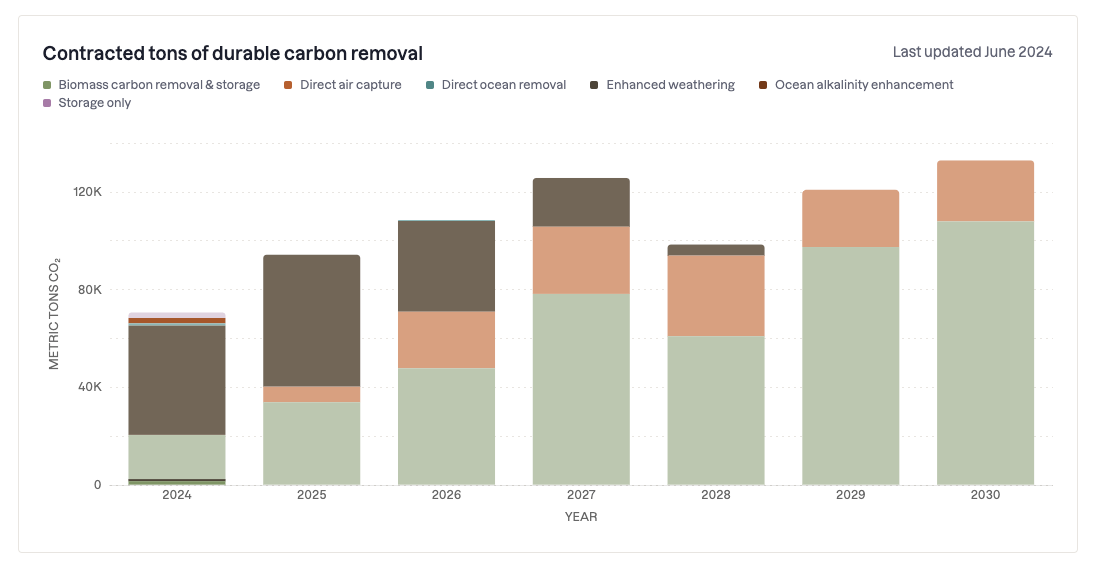A golden opportunity to accelerate carbon removal and create new revenue streams

Developed by Professor Ed Hawkins of the University of Reading, the ‘warming stripes’ graphic above paints a simplified picture of the observed changes in temperature across the globe using red and blue stripes. The warming stripes chart indicates that 2023 was globally the hottest year on record by a large margin.
Can we make the red stripes go down? Maybe!
We have a golden opportunity to collaborate and do something about the red stripes
Now more than ever, we have a window of time to take action, collaborate to resolve complex issues, and collectively achieve global sustainability goals.
The cost of inaction and not meeting the targets written in the Paris Agreement will be irreversible climate damage that future generations will be unequipped to deal with. However, we now have a clear path to take action, reach our goal, and prevent irreversible damage.
In this article, we will cover:
- A summary of our collective progress towards net-zero from 2021-present
- Key considerations and significant rate-limiting factors that are stopping us from reaching our collective goal of reaching net-zero by 2050
- Reasons why we will likely need to not only radically reduce the new emissions we put into the air, but also remove carbon already in the atmosphere
- Why right now there is a window of time for businesses to accelerate carbon removal and increase revenue by focusing on sustainability in their products
- How Kahana and Stripe Climate make it easy for individuals, SMBs, and enterprises to repurpose and sell digital products while directing a percentage of revenue toward funding R&D for promising carbon removal technologies
Let's dig in.
A comprehensive summary of our collective net-zero efforts from 2021 to the present
For context, here's a comprehensive summary of our collective net-zero progress and learnings, specifically looking at status updates year-over-year.
2021: WEF reports that we can multiply climate impact by decarbonizing supply chains... but it's hard
When the World Economic Forum (WEF) published its 2021 Industry Report on Net-Zero, there was a simple takeaway:
We need a 'next level' of climate action.
More specifically, the report identified that decarbonization of supply chains is "the next level of corporate action."
We also learned that:
- Many companies can multiply their climate impact by decarbonizing supply chains
- ...But, decarbonizing supply chains is hard
While we realized that decarbonization is hard, WEF was able to identify that decarbonizing each unique supply chain will require a different combination of eight major abatement levers:
- Circularity/recycling
- Material and process efficiency
- Renewable power
- Renewable heat
- New processes
- Nature-based solutions
- Fuel switch
- Carbon capture

2022: BloombergNEF reports that startups and innovation see negative funding growth
2023: WEF reports that public sector financing alone is not sufficient to reach global net-zero by 2050
Fast-forward from 2021 to 2023 and we have new findings and insights. The WEF 2023 Industry Report on Net-Zero brings us some good news and bad news.
2024: it's the hottest summer in the last 2,000 years and possibly the coldest summer in the next 2,000 years
Looking ahead beyond 2024 and into 2025, the elephant in the room is that carbon removal technologies have yet to receive sufficient funds to innovate and ultimately scale to meet demands for this problem.
Promising ways to fund R&D for carbon removal
We have learned that exploring ways to advance incremental investment across technology S-curves is a promising approach to maximizing returns. Currently, RD&D investments are increasingly showing upward trajectories toward commercial viability, as market conditions become more favorable to realize returns.
However, to achieve our goals of net-zero by 2050, we must act now to cultivate a supportive environment for startups, explore ways to generate stronger demand signals for carbon removal, encourage investors to identify high-potential carbon removal technologies, and do what we can to pool resources to provide teams of innovators with the funding and support networks they need to scale carbon capture to match the size of the problem.
Today, there is a window of time to increase revenue by selling sustainable products
While businesses must pool upfront time and energy to adapt supply chains, re-engineer products to be more sustainable, and create new sustainable products the payoff can happen quickly.
In short, sustainable products sell well, and the research backs it up.
You can accelerate carbon removal and build new recurring revenue streams by repurposing and selling digital products on Kahana
Kahana is a collaborative cloud-based SaaS and marketplace: an all-in-one platform that makes it easy for individuals, SMBs, and enterprises to curate, repurpose, and sell digital products.
By leveraging Kahana's direct integration with Stripe, and by extension Stripe Climate, individuals, SMBs, and enterprises can use Kahana to create and charge access to hubs of digital products while automatically directing a percentage of revenue they earn from sales directly toward funding the research and development of a portfolio of promising carbon removal technologies through Frontier.
Now, you may be wondering about how Frontier vets and selects between promising carbon removal technologies. Frontier's portfolio carbon removal companies are vetted based on the following criteria:
- They have lab-scale performance and preliminary stability data showing a proof of concept.
- Their Measurement, Reporting, Verification (MRV) approach is outlined, risks are identified, and a method is presented for reducing MRV uncertainty.
- Their Technoeconomic Analysis (TEA) is based on a process flow diagram and mass and energy balance.
- They can deliver first tons in the next ~1-3 years
| Criteria | Description |
|---|---|
| Durability | Stores carbon permanently (>1,000 years) |
| Physical footprint | Takes advantage of carbon sinks and sources that do not compete for arable land |
| Cost | Has a path to being affordable at scale (<$100 per ton) |
| Capacity | Has a path to being a meaningful part of the carbon removal solution portfolio (>0.5 gigatons per year) |
| Net negativity | Maximizes net removal of atmospheric carbon dioxide |
| Additionality | Results in net new carbon removed, rather than taking credit for removal that was already going to occur |
| Verifiability | Has a path to using scientifically rigorous and transparent methods for monitoring and verification |
| Safety and legality | Is working towards the highest standards of safety, compliance, and local environmental outcomes; actively mitigates risks and negative environmental and other externalities on an ongoing basis |
You can check out the entire Frontier portfolio, including each carbon removal company's biggest risk factors for reaching scale. You can also monitor the progress of the carbon removal technologies' current performance at any time. We encourage you to understand how the processes work and research the companies.

How to take action
Here are some ways to get started accelerating R&D around carbon removal and creating new revenue streams:
- Sign up for a free Kahana account or log in to an existing account, create a hub, connect to payment processing with Stripe, set your price, and begin directing a percentage of revenue towards carbon removal whenever you make a sale (it takes less than 15 minutes to get your paywall set up).
- Contact us to discuss ways we can partner and collaborate to build profitable and sustainable hubs of digital products that accelerate carbon removal
- For larger contributions, there are options to contribute directly to Frontier.
This interesting moment in time
To put things in perspective, right now amidst everything going on in the world, we are forced to additionally confront the crippling challenge of decarbonizing supply chains and tangibly removing carbon from the earth's atmosphere by 2050.
Said differently, we are confronted by a challenge that is so unbelievably complex and convoluted that the world's most renowned scientists and experts have sent a message to corporations that everybody must take action to a degree that can only be described as: "next-level."
Call me a fool, but I see this interesting moment in time - coupled with the fact that we have the potential to win - as a golden opportunity!

All collective knowledge, sources, and research that went into this article are pooled together in this Carbon Removal hub:


Create sustainable digital products for free
Kahana is a collaborative platform and marketplace to pool knowledge and sell digital products.

Talk with a Kahana representative
Fill out your information and a Kahana team representative will reach out to you. Have a simple question? Search our library of articles

